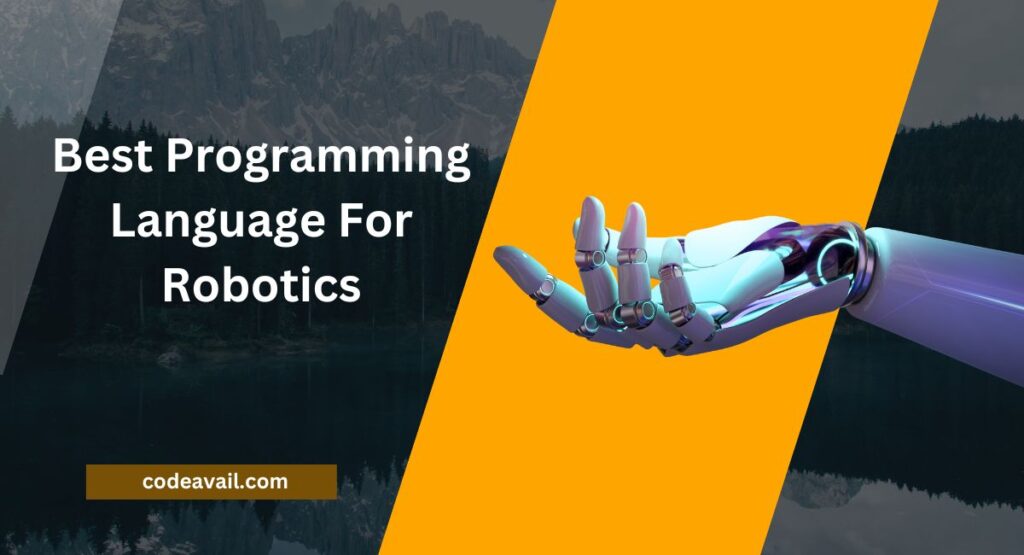Robotics has been growing in popularity in recent years, and there are now many different programming languages that can be used for the purpose.
There are several programming languages for robotics.
But python, Java and C++ are the most popular languages for Robotics. These three languages are popular with robotics developers because they have many advantages.
In addition to their versatility, these languages are also famous for their ease of use.
Robotics technologies are increasing in popularity, and there are now many Robots programming languages available.
The best Robots programming languages make it easy to create and program robots, as well as make robotics research more accessible.
Each language has its own strengths and weaknesses, but when it comes to Robotics development, it is important to choose the right one.
This article will explore one of these languages and its potential for robotics development.
Best Programming Language For Robotics
Table of Contents
Python Programming Language
Python programming language is another language that can be used for robotics.
Its libraries and functionality make it a useful tool for robotics professionals.
Programming with Python is easy, and those without any programming background can quickly and easily learn the language.
Fortunately, there are many resources available to help beginners learn the language.
A few of the advantages of Python for robotics development include its flexibility and solid user base.
However, the language lacks native support for many robot controllers, which limits its use in industrial settings.
Moreover, with the help of the proper robotics programming software, Python can be used to develop complex robotics applications.
Python is one of the best programming language for robotics development.
Its flexibility allows developers to develop a robot quickly, test it, and learn how it functions.
In addition, it eliminates the need for manual programming.
It requires fewer lines of code to design an embedded system and can be easily read by a novice programmer.
It also has a large community of support, making it easy to get help when needed.
Python is one of the easiest programming languages to learn.
The language is widely used for hobby projects and is highly readable.
Many robotics projects are written in Python because of its ease of use and beginner-friendly approach.
Python also provides the ability to write complex machine code and low-level hardware.
C/C++ is a more complex language that is not as intuitive as Python.
C++ has more lines of code, making it challenging to implement the functionality.
Python is a popular language for robotics and is becoming more popular.
If you’re serious about a career in robotics, learning Python is a must.
C++ is another mature programming language for robotics. It allows interaction with low-level hardware and provides an extensive library.
It also allows for real-time performance. It has a lot of functions and is popular with aspiring robotics engineers.
C++ is also easy to learn and is a universal language for robotics.
A mobile robot requires motors on its wheels, an embedded computer, and a microcontroller that communicates with the outside world.
The computer runs the robot application and communicates with the motor controllers. It also contains a thread that repeats a sequence.
Depending on the application, this may result in various outcomes.
C++ Programming Language
C++ is a powerful programming language for robotics. Its versatility allows you to program for a wide range of robotics tasks, from low-level motor control to high-level computer vision and artificial intelligence.
Few languages excel at these levels, but C++ and its derivatives are excellent for robotics applications.
C is a general-purpose programming language used by almost every operating system, and C++ is a popular extension.
Robotics programs are often developed using C++, but some robot-related software programs are written in Python, Java, or other languages.
The advantages of C++ programming for robotics include its versatility and speed, making it a good choice for low-level robotic applications.
It also has an extensive library and toolset to help you develop advanced robotic applications.
Other languages that are suitable for robotics programming include Prolog.
This programming language features a simple syntax that allows for clear coding and efficient programs.
Additionally, its declarative nature makes it well-suited for decision-making algorithms. Its flexibility makes it a popular choice for robotics programming, and it’s easy to learn.
Although C++ is the most common language used for robotics, C# is also helpful in some robotics applications.
For beginners, it’s a great way to learn how to create programs in a more structured way. Most robots come with proprietary programming languages developed by different manufacturers.
For example, ABB’s RAPID and Kuka’s KRL use Pascal to build robots. As with C++, however, it’s best to learn C++ and Java before diving into this language.
Robotic applications need powerful hardware and software. Robotic software should run faster than 100Hz to be smooth.
To accomplish this, the robot’s hardware must be optimized. If the robot is running on batteries, the robot must have an appropriate voltage for the application.
If the battery level is low, the robot will automatically recharge.
A C++ programming language is a powerful tool for robotics. As a successor to the C language, C++ is an object-oriented version of the same language.
This makes it possible to create robots that can operate independently. It also helps to automate tasks and develop new products.
In addition to robotics, C++ programming languages are useful for machine learning and developing ROS packages.
While C++ is the most commonly used programming language for robotics, learning could be a lot of work.
Learning C++ requires a lot of time and patience. Third-party libraries are available, but they can be challenging to use.
The main benefit of C++ is its ability to handle high-performance robotic hardware.
Robotic programming requires high-level programming skills to make the robot sense its environment.
Some examples include light sensors, touch sensors, pressure sensors, and chemical sensors.
These sensors are critical to the robot’s productivity.
Java Programming Language
Java is an interpretive programming language that allows programmers to use the same code on various computers.
This makes it useful for artificial intelligence developers, as it enables the creation of neural networks. IBM Watson, for example, was programmed in Java. (https://idigtexas.com)
The Java programming language can also be used to develop robots using artificial intelligence.
Java is the most commonly used programming language for robotics.
However, there are several other languages as well. For example, C++ is a general-purpose language widely used by software developers but not specifically designed for robotics.
In addition to being used by robot programmers, C++ is also used to develop low-level electronic systems and digital logic circuits for robots.
It is also helpful for simulation and modeling.
C/C++ is another excellent programming language for robotics.
This language is used in many areas of robotics, from sensor control to high-level computer vision and artificial intelligence.
Many companies choose this language because of its powerful library functions and developer-friendliness.
This programming language is perfect for creating the Ultimate Intelligent bot!
Java is also easy to learn, which makes it ideal for robotics projects. Java has a number of libraries and frameworks to support robotics development.
It is also platform-independent, meaning that Java code can run on any computer that supports Java.
It is also a powerful programming language for developing robots because of its wide range of applications.
Robotic systems are becoming increasingly common in our world.
From saving lives in collapsed buildings to exploring space, robots are taking on tasks that would be too dangerous, expensive, or boring for humans.
Moreover, as we rely more on robotic systems, more people are turning to artificial intelligence to make our lives easier.
Pascal, Lisp, and C++ are just some programming languages suitable for robotics. If you’re interested in robotics, it’s a good idea to learn one of them first.
They are outdated but still great for learning the basics and technical details of programming robots.
The ROS framework allows robots to share programs and codes. This helps developers integrate systems and is a common ground for all programmers.
It also provides an environment for communication among nodes written in any language. It also allows robots to work together with each other.
And you can make sure that all the nodes communicate with each other.
Python programming language is another popular choice. This interpreted language is easy to learn and has many libraries for robotics.
However, it is not suitable for real-time performance.
Nonetheless, it’s a popular choice for beginners.
There are a variety of robots that support Python.
Python may be the right choice if you want to learn more about robotics programming. It’s also popular with experienced programmers.
The field of robotics is rapidly growing as organizations invest in digital technologies.
Its applications include streamlining work, developing new products, and automating processes.
Many retail and manufacturing industries are interested in this new technology.
For this reason, learning one or more programming languages is essential.
Conclusion
In conclusion,robotics programming languages are becoming more and more popular for robotics applications.
There are many options to choose from, and each has its own strengths and weaknesses.
It is important to carefully research the best option for your specific needs before making a decision.
Robotics programming is a difficult and ongoing task that requires an understanding of the relevant technologies and tools.
All you need is dedicated efforts to learn any one of these programing languages.


